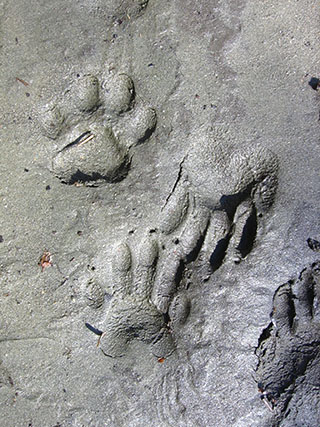Envisioning an Ideal Trailing Practice
 Bobcat and raccoon tracks in a riverbank.You can go a long way with a regular, short practice that has intention.
Bobcat and raccoon tracks in a riverbank.You can go a long way with a regular, short practice that has intention.
The ideal trailing practice is one where the “stress” comes from pushing edges related to skill. If you or the people around you feel stress because you want to practice more than you can, then the ideal might require you to back off and let the schedule be what it is. You will learn more, in any event, if you are not stressed about squeezing-in practice.
Do what you can in regular sessions. 15 minutes, if that's what you've got, can be so much better than nothing. “Regular” is more valuable in many ways than “long”. Some skills are best learned through regular practice, whether the sessions are short or long. Other skills require longer sessions, but they do not require constant practice.
Here are some skills or areas of study that are best learned from regular practice, even when done in short sessions:
-
Knowledge of environmental conditions
- Including memory of the weather
-
Knowledge of substrate
- The ground changes every day: it gets drier, it gets wetter, it gets blown around, things fall on it. By looking at it, you see the changes – even if you don’t consciously register them. Seeing changes in the substrate, even briefly, helps you to see tracks and sign there. What is important is to see the ground. If you want to analyze something you see, go for it (that is helpful for some), but that is not the most important thing. Simply expose yourself on a regular basis to the experience of seeing the ground, holding in mind the possibility that a trail may appear there
-
Aging
- Being able to assess the age of tracks or sign is about understanding the interaction between 1) environmental conditions and 2) substrate – how do wind, sun, rain, heat influence the appearance of tracks or browse or scat?
-
When you get used to seeing disturbances in the substrate, deer tracks like this one in pine needles will jump out at you.
 Seeing tracks in challenging substrates
Seeing tracks in challenging substrates
- It takes a lot of work to see tracks in leaf litter or duff, for example. If you regularly see just a few tracks that push your edge, over time you’ll be much better able to move smoothly and with momentum through tough conditions
-
Awareness
- Operating all our senses can be multi-tasking, even if we’re standing still, and when we do it with intention only once in awhile, then it can be hard to do anything else at the same time
-
Woodsmanship / knowing how, where and when to move
- If you learn the foxtrot and then practice it only once a month, then you feel like a stumblebum for the first little while every time you do it. On the other hand, if you regularly go through the steps for a few minutes, then it gets to be in your muscles, and you can give more attention to other things
Here are some skills that usually need to happen in long sessions but can be gained with more occasional practice:
-
Knowing the animal is close
- In order to be able to recognize the difference between fresh and very fresh sign, we have to get close, and generally, that requires time
-
Knowing how to approach the animal
- Again, you have to be on the trail long enough on a given day to get there
So, you can actually set up a great trailing practice if you can give yourself the occasional long session while regularly giving ½ hour or more a day for 4 days a week or so to #3 and #4 below. #1 and #2 can simply become part of your workaday life.
- Pay attention to the weather
- Imagine its effects on the substrate that you anticipate looking at
-
Move with awareness at your trailing spot and
- Notice the ground – simply notice the current qualities of the substrate
-
When you see tracks and sign:
- Consider their age
- Follow them, practicing the many things we’ll suggest
- Journal – whatever your skill level in trailing, there is an appropriate journal for you. If you fill it out during the last few minutes of your daily practice, you will bring home your experience in the field, making it more available to you
The more time you can give, of course, the quicker you will break through the frustrations that naturally attend looking for tracks and trails that are not easy to see.
© Nate Harvey, 2015
